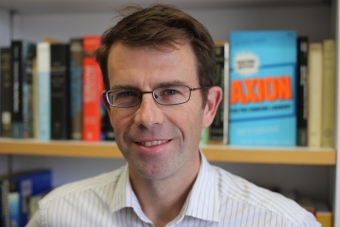
Date:
Location:
Title:
abstract
Topological phenomena in condensed matter physics provide some of the most precise measurements of fundamental physical constants. The measurement of the quantum conductance Gxy=e2/h from the quantum Hall effect and the flux quantum from the Josephson effect provide the most precise value for Planck’s constant h. More recently, the 3D topological insulators have been discovered, in which topological properties of the bulk wave functions give rise to a topologically protected surface metal with a massless Dirac spectrum. It has been proposed that 3D topological insulators are best characterized not as surface conductors but as bulk magnetoelectrics with a quantized magnetoelectric response whose size is set by the fine-structure constant. This topological magnetoelectric effect has been called “axion electrodynamics” because of an analogy that can be made to the physics of the hypothetical axion particle that was proposed to explain charge conjugation parity symmetry violation (CP violation) in the strong interaction. The quantized response differs from the situation in conventional magnetoelectrics where the constant of proportionality between polarization and applied magnetic field or the proportionality between magnetization and applied electric field is a non-universal parameter. Here the proportionality is a quantized universal number. The quantized 3D magnetoelectric effect has much in common with the theory of polarization in 1D and the 1/2 quantized surface charges that can be found in inversion symmetric 1D chains. This connection will be discussed in an extended analogy.
In the bulk of this talk however, I will describe our time-domain THz measurements of electrodynamic response of topological insulators and show how their response to polarized THz light is a measure of the quantized magnetoelectric effect. Among other aspects, the time structure used in these measurements allows a direct measure of the fine structure constant based on a topological invariant of a solid-state system.
bio
N. Peter Armitage is a physicist whose research centers on understanding material systems which exhibit coherent quantum effects at low temperatures, like superconductors and "quantum" magnetism. His principal scientific interest is understanding how is it that large ensembles of strongly interacting, but fundamentally simple particles like electrons in solids act collectively to exhibit complex emergent quantum phenomena. He is exploiting (and developing) recent technical breakthroughs using very low frequency microwave and THz range radiation to probe these systems at their natural frequency scales. The material systems of interest require new measurement techniques as their relevant frequencies typically fall between the range of usual optical and electronic methods. He has been the recipient of a DARPA Young Faculty Award, an NSF Career Award, a Sloan Research Fellowship, was a three time Kavli Frontiers Fellow, the William Spicer Award from the Stanford Synchrotron Radiation Laboratory, the William L. McMillan Award from the University of Illinois and 2016 Genzel Prize. He was also the co-chair of the 2014 Gordon Research Conference in Correlated Electron Systems.
Hosted by Stephen Wilson. Download event flyer.



